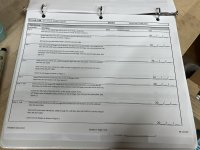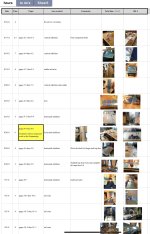MechaSteve
Active Member
I have started building my tail kit, and I want to make sure I am adequately documenting my build, before I get too far along.
Complicating matters is I have an old + new kit. Most of the kit is late 2018, but I also have newer bits (updated HS-00007 drill guide, SB-00053, etc.).
My background includes Quality Engineering, and so I made validation documents to go along with my KAI. (see attached, minor typo in Step 3 - Left)
The KAI gives rather vague advice about documentation from what I can find.
Is there a particular section that details documentation standards?
What needs to be verified and documented and what is considered proper?
My logic is that my validation document meets ALCCOA standards (and yes I know Van's mostly uses Kaiser, lol) :
- Attributable: the name and initials of the person who checked the step is given for each step.
Repeated steps are listed explicitly. Section, Page, and Step numbers match the KAI.
- Legible: a printed document is easy to read, and the name of the person checking is printed (not an illegible signature).
Date is in an unambiguous format.
- Contemporaneous: Each step is signed off as it is completed.
- Complete: Every step is documented.
Validation section and page numbers ensure that nothing is missing.
- Original: The validation document is a separate document from the KAI.
This allows the validation to be maintained as an original document, without needing to make additional copies for reference.
- Accurate: Steps are corrected from the original KAI to reflect corrections and updated parts.
Even if steps are completed out of order (e.g. machining all parts in a section before assembly) they can still be documented on the day the step was actually completed.
Complicating matters is I have an old + new kit. Most of the kit is late 2018, but I also have newer bits (updated HS-00007 drill guide, SB-00053, etc.).
My background includes Quality Engineering, and so I made validation documents to go along with my KAI. (see attached, minor typo in Step 3 - Left)
The KAI gives rather vague advice about documentation from what I can find.
Is there a particular section that details documentation standards?
What needs to be verified and documented and what is considered proper?
My logic is that my validation document meets ALCCOA standards (and yes I know Van's mostly uses Kaiser, lol) :
- Attributable: the name and initials of the person who checked the step is given for each step.
Repeated steps are listed explicitly. Section, Page, and Step numbers match the KAI.
- Legible: a printed document is easy to read, and the name of the person checking is printed (not an illegible signature).
Date is in an unambiguous format.
- Contemporaneous: Each step is signed off as it is completed.
- Complete: Every step is documented.
Validation section and page numbers ensure that nothing is missing.
- Original: The validation document is a separate document from the KAI.
This allows the validation to be maintained as an original document, without needing to make additional copies for reference.
- Accurate: Steps are corrected from the original KAI to reflect corrections and updated parts.
Even if steps are completed out of order (e.g. machining all parts in a section before assembly) they can still be documented on the day the step was actually completed.
Attachments
Last edited:






